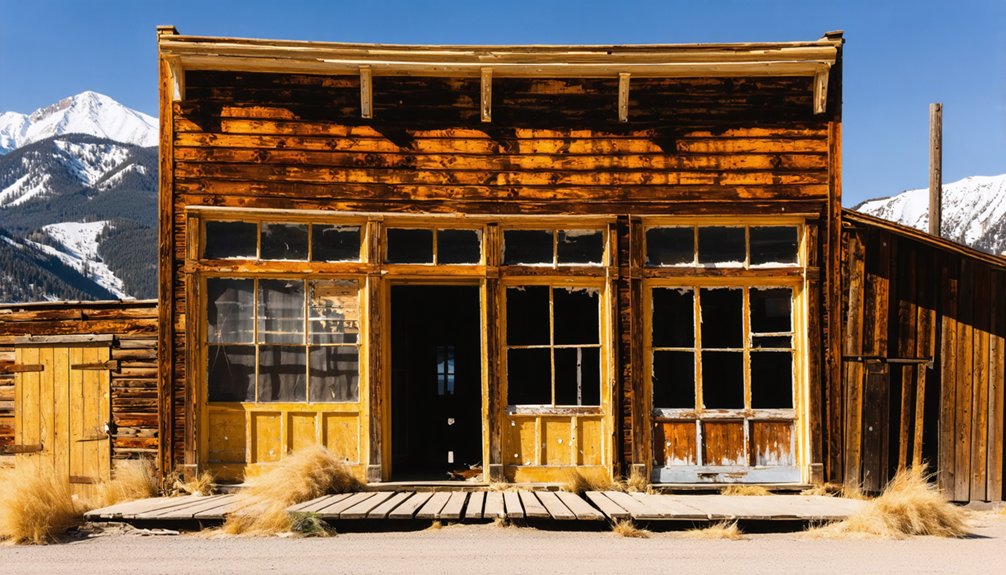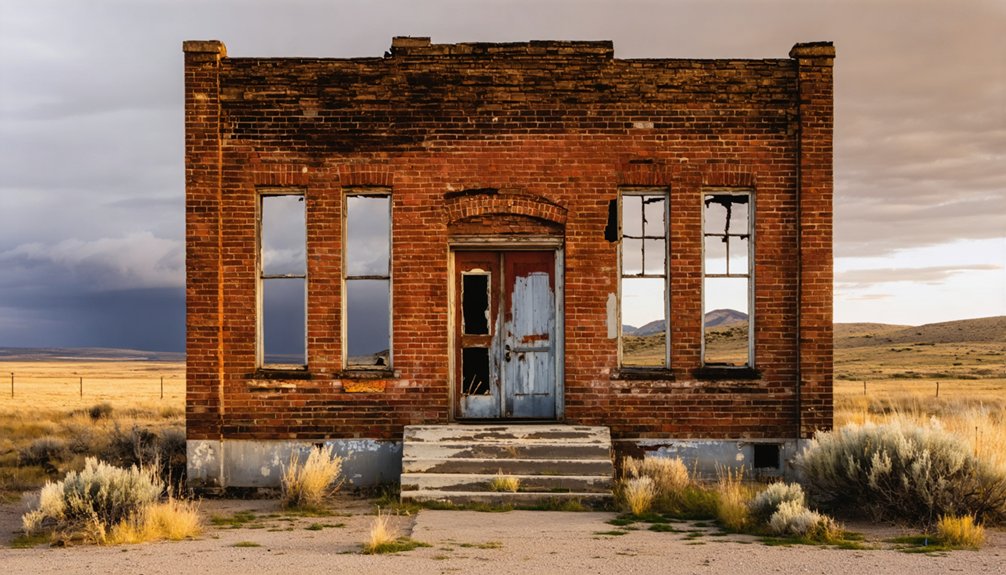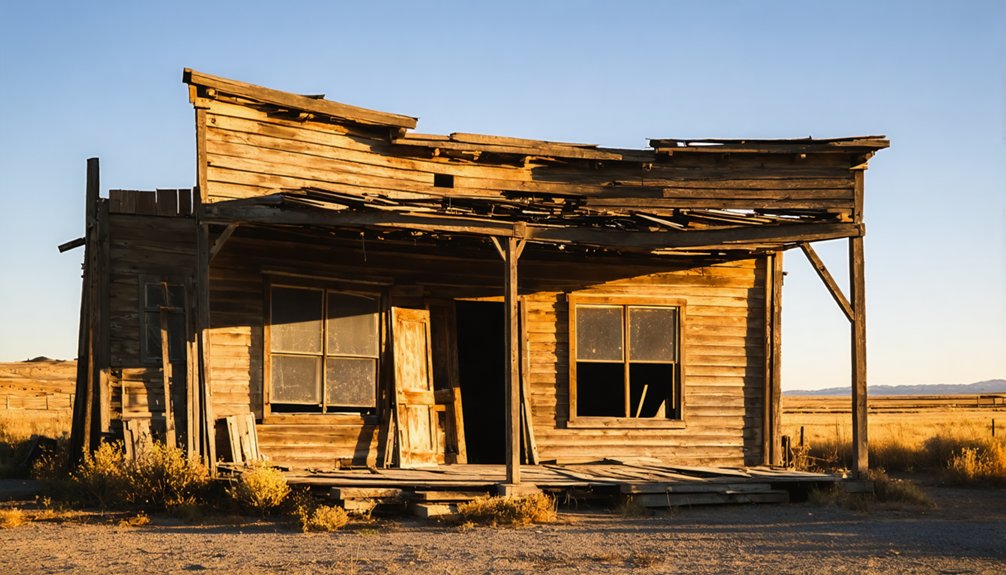You won’t find Ketchum among Idaho’s ghost towns, as it successfully transformed from a booming 1880s mining settlement into a thriving mountain resort. After the 1893 silver crash threatened to empty the town, local sheep farming and later ski tourism saved it from abandonment. While neighboring sites like Boulder City and Bayhorse became true ghost towns, Ketchum’s historic district preserves its frontier heritage through preserved buildings and haunted landmarks that reveal fascinating tales of the Old West.
Key Takeaways
- Ketchum avoided becoming a ghost town after the 1893 silver crash by diversifying into the sheep industry and later tourism.
- The area around Ketchum contains several ghost towns like Boulder City, which has preserved mining structures from the 1880s boom.
- Historic buildings in Ketchum, including the Pioneer Saloon and Ketchum Grill, maintain connections to the town’s mining past through reported hauntings.
- Originally named Leadville, Ketchum was a thriving mining town with 13 saloons, four restaurants, and two hotels by 1884.
- The town successfully transitioned from mining to tourism, becoming home to Sun Valley Resort in 1936 rather than declining into abandonment.
The Mining Boom That Built Ketchum
When prospectors discovered rich lead mines near Ketchum in 1881, they sparked a mining boom that would transform this region of Idaho Territory.
You’ll find that within just two years, four smelting plants were processing an impressive 50 tons of bullion daily, fed by 20-30 thriving mines. The ore was exceptionally rich, yielding 50-80% lead and up to 1,000 ounces of silver per ton.
Mining prosperity attracted diverse settlers, including Irish, Welsh, German, and Chinese immigrants. The area’s Guyer Hot Springs attracted many visitors seeking therapeutic mineral baths. The Wood River Valley quickly became Idaho Territory’s most progressive region.
By 1884, you’d have encountered a bustling town with 13 saloons, four restaurants, and two hotels.
However, this golden age was brief – by 1887, ore depletion in the known veins led to sharp production declines, though a brief resurgence occurred between 1911 and 1921.
From Leadville to Ketchum: A Name’s Journey
Early settlers originally dubbed their new mining settlement “Leadville” in 1880, drawing inspiration from similar boomtowns across the American West.
You’ll find that this name choice proved problematic when the US Postal Service rejected it, as other mining towns had already claimed the Leadville name.
The name significance shifted when settlers turned to David Ketchum, a respected local trapper and guide who’d staked his claim in the region. As a tall, wiry man, he had built the area’s first cabin in 1879.
His pioneering spirit and contributions to the area’s development made him the perfect namesake.
The postal history of Ketchum began when officials approved this unique name, establishing a vital hub for commerce and communication.
This name required careful disambiguation efforts to distinguish it from other locations sharing the Ketchum name.
Without this distinctive identity, you wouldn’t have found the town’s mail reaching its intended destination in those early days.
Haunted Heritage: Tales From Historic Buildings
As you walk through Ketchum’s historic district, the town’s haunted heritage emerges through well-documented paranormal activities in its oldest buildings.
You’ll find ghost sightings at the Pioneer Saloon, where “the Miner” chills empty spaces, and multiple spirits have caught the general manager’s attention.
Over at the Ketchum Grill, housed in the 1885 Ed Williams building, spectral stories tell of a male ghost in 1940s attire visible only from the waist up – his partial appearance likely due to historic floor level changes.
These hauntings connect directly to Ketchum’s mining past, with abandoned camps like Boulder Basin and Bullion serving as silent witnesses to the region’s boom-and-bust cycles. The arid climate has helped preserve many original structures, allowing visitors to step back in time.
The town’s historic buildings, from St. Mary’s Catholic Church to the Ketchum Kamp Hotel, preserve these supernatural connections. The area’s earliest inhabitants, the Native American tribes, including Bannocks, Sheepeaters, and Shoshone, lived here for over 11,500 years before European settlement.
Abandoned Treasures: Neighboring Ghost Towns
Beyond Ketchum’s historic streets lie scattered remnants of Idaho’s pioneering spirit in the form of enchanting ghost towns.
Across Idaho’s rugged terrain, abandoned settlements whisper tales of frontier dreams and the untamed American West.
You’ll discover a wealth of mining relics and pioneer settlements, each telling unique stories of Idaho’s frontier past. The small-town charm of modern Ketchum echoes its own rich history.
- Boulder City invites ghostly explorations among its preserved mining structures and artifacts in the Basin region. Take the Boulder City Road north from Ketchum to access this remote historical site.
- Bayhorse offers a remote forest adventure with its silver mining ruins in the Salmon-Challis National Forest.
- Chesterfield stands as a representation of Mormon farming heritage with its well-preserved pioneer buildings.
- Silver City remains one of the region’s most complete mining ghost towns, featuring intact saloons and shops.
- Additional treasures like Bullion, Vienna, and Galena dot the landscape, each preserving pieces of Idaho’s mining and logging heritage.
Transforming From Silver to Tourism
The discovery of rich galena deposits in the Wood River Valley sparked Ketchum’s meteoric rise in the 1880s.
You’ll find that this boomtown’s journey from mining powerhouse to world-class resort showcases remarkable economic adaptation. At its peak, four smelters processed 50 tons of silver daily until the crash of 1893 brought the boom to an end.
But Ketchum didn’t become a ghost town like its neighbors. The sheep industry kept the town alive, and the Union Pacific Railroad proved essential for what came next. The railroad’s branch line to Ketchum became a crucial connection for the region’s development.
In 1936, visionary Averell Harriman transformed Ketchum’s industrial foundation into America’s first destination ski resort – Sun Valley. This shift to silver tourism preserved Ketchum’s liveliness, as mining buildings and rail infrastructure found new purpose serving winter sports enthusiasts.
Preserving the Past: Ketchum’s Legacy Today
While Ketchum’s mining heyday has long passed, you’ll find its rich heritage carefully preserved through robust preservation efforts. The town’s Historic Preservation Commission actively protects 24 designated historic properties, ensuring they remain authentic while adapting to modern uses. The area’s transformation began when Galena Summit was first discovered in 1824, marking a pivotal moment in the region’s accessibility and development.
You can explore these living pieces of history throughout the Community Core, where historic preservation meets community engagement.
- The McAtee House stands as a pristine example of 1930s log cabin architecture
- Forest Service Park holds national historic status, protecting its legacy
- The Pioneer Saloon adds intrigue with its legendary “Miner” ghost
- Ketchum Grill’s 1885 building reveals original foundations and mysterious tales
- Local preservation guidelines encourage thoughtful redevelopment while maintaining historic character
Frequently Asked Questions
What Was the Average Salary of Miners in Ketchum During Peak Operations?
Like gold dust scattered through time, you’d find mining wages varied, but during peak operations, miners likely earned between $2-4 per day, creating substantial economic impact across the region.
How Many People Lived in Ketchum During Its Most Prosperous Mining Years?
You’ll find population dynamics during the mining boom weren’t precisely documented, but estimates suggest between 2,000-5,000 people lived there, supporting multiple smelters, 13 saloons, and various businesses.
Are There Any Remaining Mine Shafts That Visitors Can Safely Explore Today?
With over 900-foot drops in some shafts, you can’t safely explore any mines today. Mine safety guidelines strictly prohibit visitor entry due to dangerous structural instability and risk of collapse.
What Indigenous Tribes Originally Inhabited the Ketchum Area Before Mining Began?
You’ll find the Shoshone, Bannock, Lemhi, and Tukudika (Sheepeater) tribes originally called this area home, with significant tribal significance spanning over 10,000 years of Native American history in these mountains.
Which Mining Companies Still Own Land Rights Around Ketchum’s Historic Mining Sites?
You’ll find Idaho Strategic Resources dominates land ownership, controlling 7,300 acres and major mining rights around historic sites. Other claims are scattered among private holders, though records aren’t fully transparent.
References
- https://sunvalleymag.com/articles/spirits-of-sun-valley/
- https://sunvalleymag.com/articles/searching-for-ketchum/
- https://www.lib.uidaho.edu/digital/postcards/items/nwpostcards1182.html
- https://idaho-forged.com/idahos-ghost-towns-eerie-yet-approachable/
- https://miningconnection.com/surface/featured_stories/article/idahos_mining_ghost_town_is_destination_for_hardy_adventurers
- https://www.sawtoothcityidaho.com/history
- https://npshistory.com/publications/blm/historic-mines-blaine-co.pdf
- https://visitidaho.org/things-to-do/ghost-towns-mining-history/
- https://visitsunvalley.com/about-sun-valley/history/
- https://www.co.blaine.id.us/364/History-Statistics



